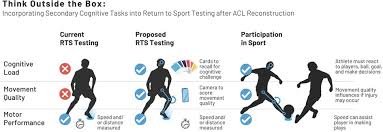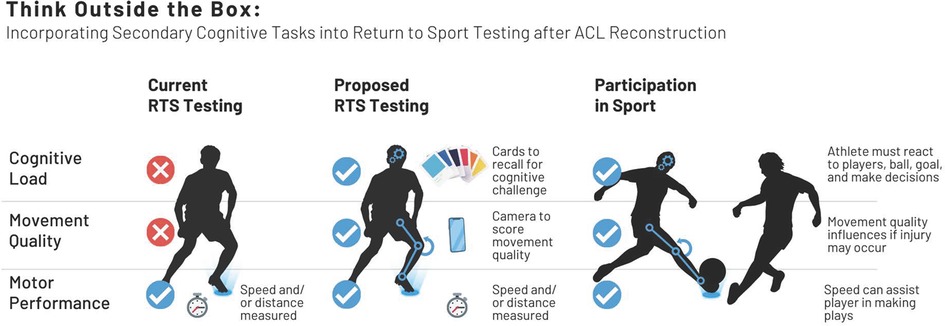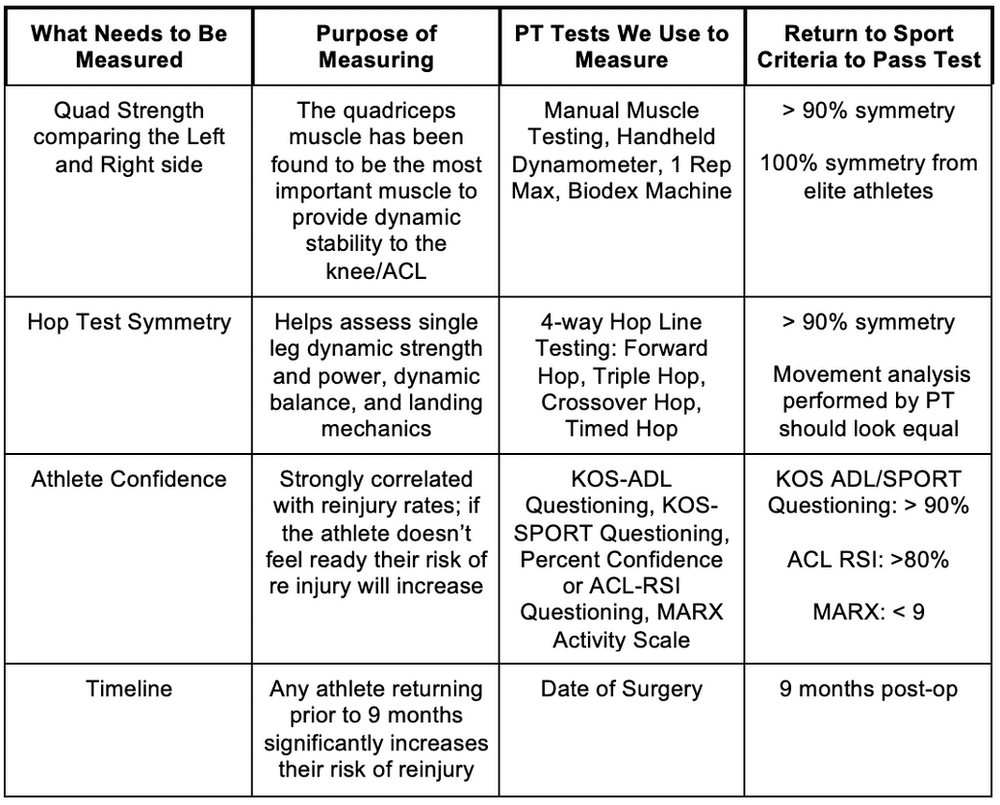Returning to sports after an ACL injury can be challenging. Proper testing ensures readiness and reduces the risk of re-injury.
ACL return to sport testing is crucial for athletes. It evaluates strength, flexibility, and stability. This testing helps determine if an athlete is ready to safely resume their sport. It includes various tests and assessments, conducted by professionals. These tests ensure the knee has healed properly.
They also check if the athlete can perform at their previous level. Proper testing is vital to avoid future injuries. It provides peace of mind for athletes and coaches. Understanding this process can help you or someone you know make a safe return to sports after an ACL injury.
Initial Assessment
Returning to sports after an ACL injury requires a thorough initial assessment. This step is crucial to ensure a safe and effective recovery. The assessment focuses on understanding the current state of your knee. It helps set realistic goals for your rehabilitation journey. Let’s delve into the key components of this initial assessment.
Baseline Functional Tests
Baseline functional tests gauge your knee’s current abilities. These tests measure balance, agility, and coordination. They help identify any deficits caused by the injury. Results from these tests serve as a benchmark. They guide the rehabilitation process and track progress over time.
Strength And Mobility Evaluation
Strength and mobility evaluation is another vital part. This evaluation checks the strength of your leg muscles. It also assesses the range of motion in your knee. Strong muscles and good mobility are essential for a safe return to sport. Weakness or limited mobility can increase the risk of re-injury.

Credit: www.evolutionphysicaltherapy.com
Rehabilitation Protocols
Rehabilitation protocols are vital for athletes recovering from an ACL injury. These protocols ensure a safe and effective return to sport. The process includes a phased recovery plan and various therapeutic exercises.
Phased Recovery Plan
A phased recovery plan allows for gradual progress. This plan usually consists of several stages:
- Initial Phase: Focuses on reducing swelling and pain. Rest, ice, compression, and elevation (RICE) are key.
- Intermediate Phase: Emphasizes restoring range of motion. Gentle stretching and basic strength exercises are introduced.
- Advanced Phase: Aims to regain strength and balance. More complex exercises and low-impact activities like swimming are added.
- Return to Sport Phase: Prepares athletes for sport-specific movements. High-intensity training and agility drills are key components.
Therapeutic Exercises
Therapeutic exercises are crucial for rebuilding strength and flexibility. They include:
- Strengthening Exercises: Squats, lunges, and leg presses help build muscle strength.
- Flexibility Exercises: Hamstring and calf stretches improve flexibility.
- Balance Exercises: Single-leg stands and stability ball exercises enhance balance.
- Cardiovascular Exercises: Low-impact activities like cycling and swimming boost endurance.
Each exercise targets specific areas to ensure comprehensive recovery. Regular practice under supervision helps achieve the best results.
Functional Testing
Functional testing is a key part of ACL return to sport testing. It involves various assessments to ensure the athlete is ready for physical activity. The goal is to gauge movement quality, balance, and stability.
Movement Quality Assessment
Movement quality assessment helps in understanding the efficiency of an athlete’s movements. This type of testing looks at how well the athlete can perform basic movements. It includes:
- Squats
- Lunges
- Jumping and landing
Experts observe for any compensatory patterns or asymmetries. Proper form is crucial. Poor movement patterns can lead to injury. Hence, this assessment is vital.
Balance And Stability Tests
Balance and stability are core components of athletic performance. These tests measure how well an athlete can maintain control. Common tests include:
- Single-leg stance
- Balance beam walks
- Dynamic balance tests
During these tests, athletes perform tasks on one leg or unstable surfaces. The tests assess the ability to stay stable under various conditions. This is essential for preventing re-injury.
| Test | Purpose |
|---|---|
| Single-leg stance | Assesses static balance |
| Balance beam walks | Tests dynamic balance |
| Dynamic balance tests | Evaluates stability during movement |
Functional testing is comprehensive. It ensures athletes are physically ready to return to their sport. Movement quality and balance are critical to avoid future injuries.
Performance Metrics
Performance metrics play a crucial role in determining readiness after an ACL injury. These metrics help assess whether an athlete can safely return to their sport. The focus is on various physical abilities. This includes speed, agility, and endurance. Each of these areas provides valuable insights.
Speed And Agility Testing
Speed and agility are essential for athletes. Tests in this category measure quickness and changes in direction. Common tests include the 40-yard dash and the T-test. These tests assess bursts of speed and rapid movement. They help ensure the athlete can handle the demands of their sport.
Endurance Measures
Endurance is about lasting power. It determines how long an athlete can perform before tiring. Tests like the beep test or the Yo-Yo test are common. These tests measure cardiovascular fitness. They ensure the athlete can sustain performance over time. Proper endurance is vital for a complete return to sport.
Psychological Readiness
Psychological readiness is vital for successful ACL return to sport testing. Confidence and mental resilience support physical recovery.
Recovering from an ACL injury is not just about physical strength. Psychological readiness plays a crucial role in returning to sport. Athletes must feel mentally prepared to perform at their best. This section will delve into two key aspects: Mental Health Assessment and Confidence in Return to Sport.
Mental Health Assessment
A mental health assessment is essential for athletes recovering from an ACL injury. It helps identify any psychological barriers they may face. These barriers can include anxiety, depression, or fear of reinjury. Addressing these issues early can aid in a smoother return to sport. Therapists often use questionnaires and interviews. These tools help gauge an athlete’s mental state. Regular assessments ensure that mental health is monitored throughout the recovery process.
Confidence In Return To Sport
Confidence is a key factor in an athlete’s return to sport. Athletes need to believe in their ability to perform. This belief can significantly affect their performance and recovery. Building confidence involves setting realistic goals. Achieving small milestones can boost an athlete’s morale. Support from coaches and teammates also plays a vital role. They can provide encouragement and reassurance. Visualization techniques can help as well. Athletes imagine themselves successfully performing their sport. This mental practice can enhance their confidence. Regular practice of these techniques can make a big difference. Ensuring psychological readiness is crucial for a successful return to sport. Focusing on mental health and confidence can lead to better outcomes. Athletes who feel mentally prepared are more likely to succeed. “`

Credit: wesleywangdpt.com
Sport-specific Drills
Returning to sport after an ACL injury requires careful preparation. Sport-specific drills are vital in this process. These drills mimic real game movements, improving the athlete’s confidence. They also target the skills needed for the specific sport.
Tailored Skill Work
Each sport has unique movements and demands. Tailored skill work focuses on these specific needs. For soccer, it involves dribbling, shooting, and passing. Basketball players practice dribbling, shooting, and quick direction changes. These drills help athletes regain their sport-specific skills. They also ensure the injured knee can handle these movements.
Simulated Game Scenarios
Simulated game scenarios are another crucial part of sport-specific drills. These drills recreate actual game situations. They involve other players, making the practice more realistic. For example, soccer players practice against defenders. Basketball players run plays with teammates. These scenarios help athletes test their skills under pressure. They also build confidence in their knee’s strength and stability.
Final Clearance
Final clearance for returning to sport after an ACL injury is critical. This phase ensures the athlete is truly ready. It involves a thorough assessment by the medical team. Safety is the top priority. Let’s explore the essential criteria for safe return and the necessary medical team approval.
Criteria For Safe Return
Athletes must meet specific physical benchmarks. Strength and stability are key. The injured leg should be as strong as the uninjured one. Balance and coordination tests are also important. Passing these tests minimizes the risk of re-injury.
Functional performance tests are conducted. These include jumping, cutting, and pivoting movements. The athlete must perform these without pain. Confidence in their movements is essential. Psychological readiness is also assessed. Fear of re-injury can impact performance.
Medical Team Approval
The medical team plays a vital role. This team typically includes doctors, physical therapists, and trainers. Each member assesses the athlete’s readiness. They ensure all benchmarks are met. The athlete’s health is their top concern.
Doctors review medical history and conduct physical exams. Physical therapists evaluate strength, flexibility, and function. Trainers provide insights on sport-specific readiness. They ensure the athlete can meet the demands of their sport.
Once all assessments are complete, the medical team meets. They discuss their findings and make a collective decision. Only then is the athlete given the final clearance to return to sport.

Credit: www.frontiersin.org
Post-return Monitoring
Post-return monitoring is vital for ACL return to sport testing. It ensures athletes regain full function and prevent re-injury. Regular assessments help track progress and adjust training plans.
After an ACL injury, returning to sports is a major milestone. But the journey does not end there. Post-return monitoring is crucial to ensure long-term success and health. This involves tracking performance and implementing strategies to prevent re-injury. Regular assessments help athletes stay on the right path.
Ongoing Performance Tracking
Tracking performance is vital. It helps identify improvements and areas needing attention. Regular tests can measure strength, agility, and endurance. Coaches and therapists can then adjust training plans. Keeping detailed records ensures progress is consistent and meaningful.
Injury Prevention Strategies
Preventing re-injury is key. Athletes should focus on strengthening exercises. These exercises target the muscles around the knee. Balance training is also important. It improves stability and reduces the risk of falls. Proper warm-ups and cool-downs are essential. They prepare the body for intense activity and aid recovery. Regular check-ins with a healthcare provider can catch potential issues early. “`
Frequently Asked Questions
What Is Acl Return To Sport Testing?
ACL return to sport testing evaluates an athlete’s readiness to resume sports after an ACL injury. It includes physical, functional, and psychological assessments. This ensures the athlete’s safety and performance capabilities.
Why Is Acl Return To Sport Testing Important?
ACL return to sport testing is crucial to prevent re-injury. It ensures the athlete has regained strength, stability, and confidence. Proper testing helps in making informed decisions about returning to sports.
How Long Does Acl Return To Sport Testing Take?
ACL return to sport testing typically takes several hours to a full day. This depends on the athlete’s condition and the tests involved. Comprehensive assessments ensure accurate results.
What Tests Are Included In Acl Return To Sport Testing?
ACL return to sport testing includes strength, agility, balance, and functional movement tests. Psychological assessments may also be included. These tests provide a complete evaluation of the athlete’s readiness.
Conclusion
Returning to sport after an ACL injury requires careful testing and patience. Follow the guidelines and consult your doctor. Progress at your own pace. Stay positive and motivated. Your dedication will pay off. Proper testing ensures a safe return to your favorite activities.
Stay consistent and listen to your body. Celebrate small victories along the way. Your journey back to sport is achievable. Stay focused, stay strong, and enjoy the process.



